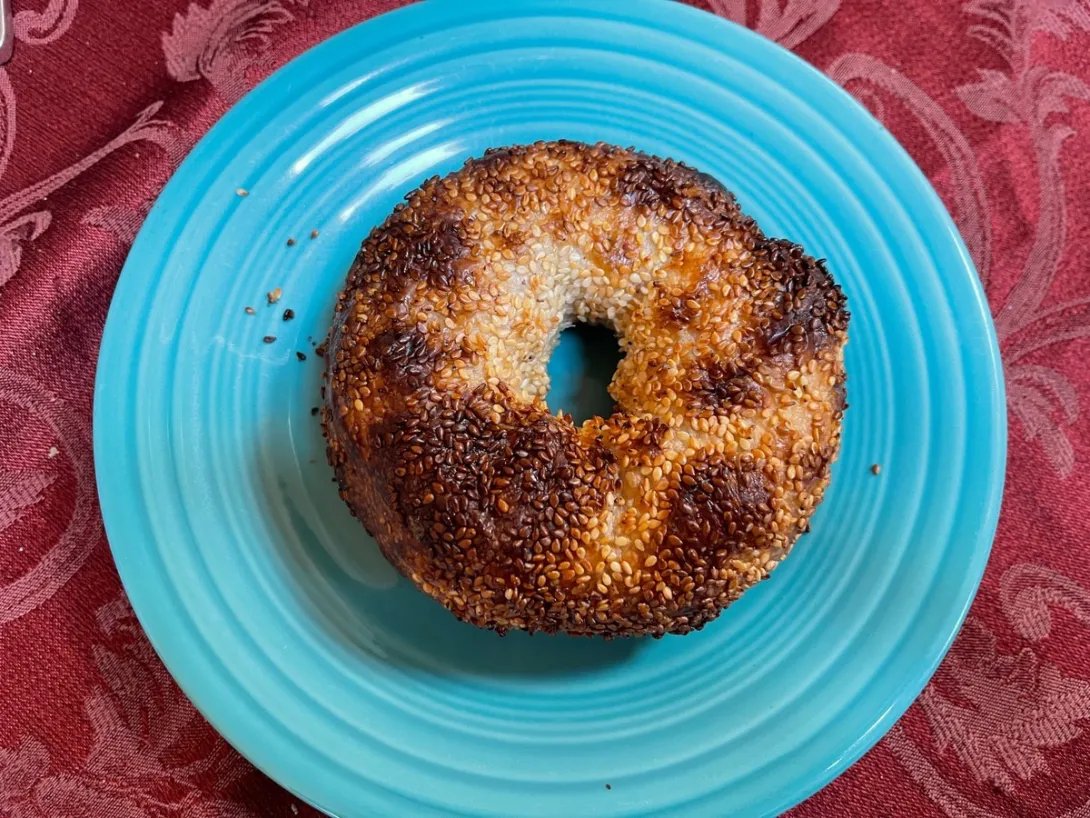
Hi there baking bagel community - I live in London - and have seen the craze for Courage Bagels online in LA - as a bagel enthusiast, would love to have a crack at these bagels at home. (No travelling due to the pandemic)
Any thoughts or tips on how to recreate this bagel? they look so different and crusty / chewy
Looks like a sourdough bread roll boiled...so Im guess high hydration and even a autolyse method...or perhaps a worked pizza dough boiled and baked?
Any thoughts? comments
all the best
bagel_fan_21
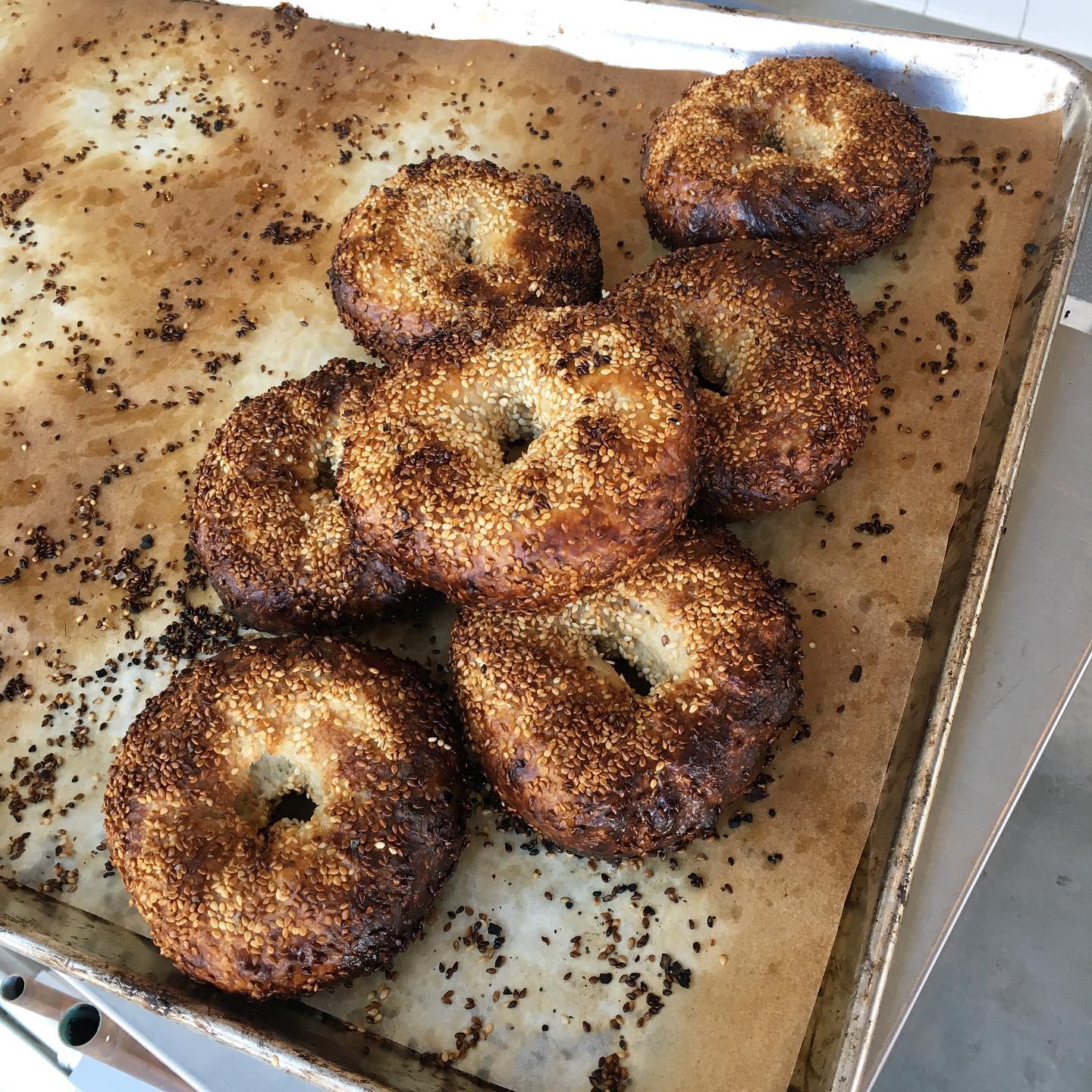
I had not heard of them before, so I read a few articles. Sounds like they specialize in Montreal style bagels. Perhaps doing a google search would get you the recipe/technique you are hoping for. (And kudos to any eatery that was able to start up and thrive during CA severe lockdowns, quite a number have not fared nearly so well.)
Good luck!
Bagels are generally low hydration actually. Check out the recipe on The Perfect Loaf site.
It takes a pandemic with the loss of tastebud sensitivity to come up with a burnt bagel that tastes good. From California? A state with one of the highest infectious rates? Hmm. I like a bold bake but this is too much burnty for me. Seeds tend to get bitter when burned. "Courage" Antigen test.
Ok, kick my sweet little 'ol Lady butt now. -Mini
No, no - burnt seeds = bitter.
Still, perhaps better than when I tried to add some sesame seeds to a baguette and, only after I had it in the oven, did I realise that I had used the SOAP water spray bottle to wet the top of the loaf!
i’m obsessed with them too. been keeping an eye on their instagram and reading articles and all i’ve gathered is the following... yes, sourdough. no wood-fire, looks like a bank of old convection ovens. honey in water. though she calls her style california-montreal, there really doesn’t seem to to be any likeness to montreal style other than honey, 🤷♂️. i plan on going in may or june and hopefully gather some more intel.
yes - looks like a very robust pizza dough...high H20....possibly made with a pre ferment/starter...even a ciabatta boiled....then baked...yes they look so moorish...would love to try them...
thanks
these bagels are out of this world. Shatteringly crisp with an open crumb and chewy interior. I'm hopelessly addicted and venturing across town every other week to get my fix.
A bagel with an open crub? Lol. My dictionary is laughing.
Has anyone tried recreating this bagel? It's unlike anything I've had. BTW, it's not much like a Montreal bagel. I wouldn't try attempting it unless you've actually tasted it. It's this unique chewy hybrid of tasting like a bagel but having with an exterior that's crisp and crackly like a baguette.
interesting yes i live abroad so i haven't managed to try these amazing looking bagels IRL - but from a lot of photos it looks like a baguette hybrid pizza dough high h20 % with natural levain....slow cold fermentation? but how so crispy perhaps they are just cooked quite hard in a convection oven rather than a deck oven...need to have a play at home.
have you had any luck trying to recreate?
they are boiled, as are most bagels. they are high(ish) hydration, id guess 70%. they are baked on parchment lined sheet pans in an old oldschool convection oven. they are naturally leavened. don't know how long ferment. the proofed dough portions are stored in stacking pizza doughtrays. the dough portions are opened up by coating with flour, poking a hole and gently opening up the hole before dropping in the boiling water.
the natural fermentation, higher hydration and boiling are what I'd guess lead to the shattering delicate outer crust.
Excellent intel i think the trick is all in the shape and tension of the fermented dough. Thank you !
or in their case the lack of shape and tension. my observation is that these dough portions had minimal preshape and tension (unlike a portion of pizza dough ball) and were more just delicate pillowy blobs like foccacia dough. then doused in flour, a hole pinched in the middle and delicately opened, then dropped in the kettle.
Fantastic stuff - loving this! - it would make sense poaching gentle light fluffly clouds - need to experiment and visit courage once travel restrictions are lifted. do you think they rest a little before hit the water? or just hole and boiled?
they dough blobs were definitely rested/proofed. after the hole was formed there was no/minimal rest. cant remember for sure if it was stretch hole and immediately into water, or if they stretched out the whole tray and then plopped them in all at once, but either way, no measurable rest.
zooming in on those photos looks like a ciabatta dough so high h2o .... any sweetness in the bagel? or just straight up crunchy goodness?
i'd guess 70%. maybe up to 75%. but really doubt it was in ciabatta 80% range. no perceivable sweetness or fat, but somewhere i ready they used honey in their bagels. but in bagels, the sweetener (usually malt) is in the boiling and often but not always in the dough. if in the dough, i'd guess prob not more than 2%. the most striking part was their crunch/shatter and open holes, both not typical of bagels.
and while you're in the southland, rent a car and go to folks pizza in costa mesa. probably the best pizza i've ever had, and that's coming from a pizzeria owner that makes pretty great pizza.
Anyone make any headway on testing these? Or find more information on their process?
My boss is obsessed with us making these. She prefers higher hydration breads. I've been testing at 85% and as you can imagine, it's not going well. I've gotten some good flavor but they can't maintain much shape so they get thin.
I want to get back down to 75% I think. We make our pizza dough at 70% so I may boil that tomorrow just to see what the crumb looks like.
i played around a few months ago. need to try again now that i have a new pizza oven and my spiral mixer is working again.. don't remember the hydration i tried, but nothing too crazy. probably low 70's. also experimented with lye in the water and honey in the water. didn't make anything fantastic, just a lot of ok. just based on my own pizza dough experiments, i doubt it's much more than +/- 70%. i really should have payed attention to any observable color in the water and the time they boiled. i need to send someone to go spy.
what pizzeria do you work for?
Above 70% is very hard to work with but their holes are so big, so I do wonder. What flour(s) do you think they're using? Actually as a test this weekend, I tested boiling off some of our 70% pizza dough and I wasn't mad at it! It was pretty decent. We use Central Milling Artisan and Farmer's Ground Half White for our pizza.
Also what do you think they do to get that super shattery crust? That one is also stumping me.
I work at Talula's in Asbury Park NJ.
Maybe they baked it twice?
they're just baked once in those super oldschool convection ovens you see in the photos. it's a tiny kitchen always at max capacity. its everything to do with the gentle pillowy fermentation/proofing and just the right amount of boiling to gel the starches on the exterior of the dough, but not too much the turns it into leather, that forms the shattery crust. writing this out though, makes me want to try dusting them with corn or potato starch or superfine 00 flour instead of just "regular" flour for pre-boil. maybe the shatter is accentuated by a goating of starch ¯\_(ツ)_/¯.
in the boiling water? Not enough to thicken it but just enough to make a super thin coating. What else? Slightly salted water? Malted water?
Yes no idea how the crust is formed … I think it’s all about a nice long ferment on the dough shaped into balls - poke - then let the dough relax again - poke / make the whole and straight into just simmering water? Then into a super hot convection oven. I also think these may have a natural levain which gives it the random holes…but it’s all todo with the way it’s shaped just before boiling so you don’t ruin those beautiful air bubbles - I also think dusting with 00 flour or even olive oil before going into the oven is a good idea.
I will have another shot at them and try and post some pictures. Can’t wait to crack the code … unfortunately I don’t have a natural starter so will try a poolish and really long bulk ferment prior to shaping. Wish me luck
Hi gang - so my first attempt at cracking the courage bagel formula
I made a
Day 1
9pm: made a Poolish with organic bread flour and fresh yeast (tiny amount)
Let this go overnight.
Day 2 (morning time)
Mixed flour with poolish (mix of t55 and strong white bread flour), at around 70% hydration, 2%salt, and some malt extract syrup and Tiny more amount of yeast mixed well (it was a small amount) then mixed in about 1.8% of salt.
Bulked this at room temp and did a few coil folds (small amount of dough so it was a pain to do the folds) through the out the day then fridged the dough overnight. a good 20 hours i would say.
Day 3
Dough i think may have over proved? it was nice and jiggly and good ferment. So shaped into balls and clothed. Then made a hole, rested / proved again / then strecthed the hole just before boiling in malt syrup - into a as hot at it goes domestic fan oven.
Results were great ..good flavour and chew and very light with a nice crust... but still not amazing shattering crust and crumb structure a little tight at such a high water content...perhaps over proved in the fridge?
I'm not sure yeast poolish can get same effect as a natural levain perhaps used in the courage bagel.
see pictures below any thoughts/comments/ideas/ get in touch! thank you.
nice! how was the crust? did you get a good shatter? fwiw, here are a couple observations of yours vs theirs...
pretty sure i've read they use honey, not malt. not sure if that's in the dough, the boil or both.
from my in-person observations, bagels went straight from proofed pillow -to- poking a hole and stretching it open -to- dropping in the kettle... no 2nd proof.
guessing time in the kettle is one of the keys to the shatter.
despite poolish instead of starter, you got nice open crumb and fermentation bubbles.
i keep meaning to test out another idea of adding some sort of starch to the water..
i need to go visit again and take way better notes and peek at they're recycling, or find a spy to watch and take notes.
Mine have a nice crust (blisters) but not that shattter like crust Courage seem to achieve..also my crumb seems to be quite small ''alveoli''.... I'm still convinced perhaps a natural levain would help.
Further points: The courage bagels seem to have semolina or cornmeal dusted over them (I assume pre boiling (you can see these flecks of grains in different photos) i will have a go at shaping into balls and then poking before boiling perhaps this gives tension when dropping into the water.
Would be interested to try with a rice starch or potato starch in the kettle but i don't think it would be that technical on the courage invention end. Credit to them they (Courage) have really found a new process in the food world which you just dont really see often!
gonna try my hand at it again this weekend. gonna try baking them in my pizza oven. and it sounds like im gonna be in LA again oct 22. hopefully family wants to go there for 1st lunch. 'll try and peek at their flour stack and/or recycling, and better observe boil times etc.
i think i'll do 70% h20, 20% starter, same day bake.their bakery is tiny, i doubt they'd have the refrigeration to retard. maybe i'll retard some. and try a minimal boil... less than 30-60 sec max..
in reading your notes, i see you put your bulk in the fridge. putting the bulk in the fridge you usually end up with inconsistent fermentation... the outside cools off fast and goes to sleep, while the center takes forever to cool off resulting in over fermented as you stated you feared. i always bulk at room temp and then ball if pizza or put in bannetons if bread and cool everything as quickly as possible.
Any updates on replicating the Courage bagel at home?
Stiff starter, around 66% 4 hours off feed
70% hydro dough
mix harder than you would a country dough, smooth and elastic
fold twice in 30 minute intervals
bulk for an hour
preshape 150g
final shape and proof 2-3 hours
retard overnight
generous amount of honey for poaching
2 minutes per side
bake @ 450 high fan
Boom… courage bagel
Thank you for this advice i must give this a go.
Furthermore...have you actually made this IRL? My main concern is retarding the final shape (i assume you ball the dough?) overnight - surely they would just spread into flat pizza doughs..making it impossible to shape into a bagel before boiling the next day?
And i don't understand the preshape and then final shape...as i think courage just ball the dough, then when it comes to boiling and baking they poke a hole and make the shape at this stage.
Thanks.
i haven't had any time to try it agian. but start things up again and give it a whirl.
Any luck at giving that a go? Or any new information you found out? I’m going to try the recipe you listed earlier, the photos look great. The airy crumb probably has to do with the natural sourdough instead of the poolish and maybe a longer ferment? You got nice color though and they still look tasty! The shattery crust may come from the honey poaching. Years ago an article came out with their home business being ranked and they mentioned the honey water. That may help give it that sheen too. Not too sure though. Would love to work there for a week and learn it all.
also closely observing, they're proofed in their solid pillowy balls in bins (no holes), then fully coated in some sort of flour or starch (rice flour? who knows, jury is still out), then the holes are formed right before boil in honey water, maybe a few minutes on each side?, then pulled out, rolled in toppings, then on parchment trays into the run of the mill convection ovens.
very close to their product. I've had it twice recently.
now the breakdown you mention doesn't have specifics with temps, proofing times and %'s. would you mind sharing exact step by steps? I really want to use the recipe to recreate their bagels.
thanks
nobody here has the exact recipe and step by step,that's why we're all here. all anyone has is little bits from observation, asking questions and tidbits from articles.
Relating to the recipe above of the person who tried to replicate it. They did a similar bagel. I was referring to that
Hello! Would you please provide the full recipe with ingredients and step by step? Thank you!
FYI found this article including a recipe for Bialys at home from the Courage owner.
https://us.inbedstore.com/blogs/journal/bialy-with-courage-bagels-arielle-skye
If I read it correctly it uses a 100% hydration.
well, flour by volume of horribly imprecise, but let's say 3c bread flour is 420g and 1.5c water is 360g, that comes out to be 85% hydration.
This article came out last month and there are some photos of the poaching water and some of the process. The water does look a bit dark, could it only be honey? Or more??
https://la.eater.com/2023/7/13/23789902/courage-bagels-los-angeles-california-style-laylas-belles-boil-bake-tomorrow-bagel-hot-water-cafe
Well it’s been a day of deep diving and research/stalking haha. I found a photo deep on the owner’s instagram of them pouring the organic barley malt syrup into the water! This helps confirm the water, probably both honey and malt.
yes amazing digging! and thanks to whoever posted that eater article great read.
I think it's more about dialling in the process from mixing to bulking / shaping and that process to the boling: i wonder if they are made on day and shapes with active starter and high hydration i can't imagine them being rested overnight at a high high hydration shaped into balls as they would just turn into flat pizzas...my guess super worked dough high gluten flour or a organic flour mixed - bulked? - shaped- rest - proved up - poked and boiled then baked?
need to have another experiment.
love the research on here thank you!
That’s a good theory. In a photo I found from the home business right before opening the shop, there’s a note written the board saying “friday, 50 degree bulk ferment from ripe starter AM”. I assume this was to sell on Saturday farmer’s markets, so maybe that helps a little with figuring out the timing process of everything?
I haven’t been able to find recent photos showing the flours they’re using but I found a photo taken from her home business prior to the brick and mortar with bags of King Arthur whole wheat and King Arthur sir Galahad AP
is anyone in the ground in LA would be serious intel to know how much space they have - if they dont have a cool room/ walk in fridge then i think i they would be making very early on a super super active starter -
there is a quote from the LA eater article: which i think personally is not true : 6 days ?? i dont think thats to throw us of the scent ;-0
One common thread in the contemporary local bagel scene is to treat bagels more like artisanal bread. Courage’s bagels are handmade, naturally fermented, and take about six days, from start to finish, to make.
Yes! I’m 2 hours away and was planning on going this week to really study. I’ve been before but wasn’t thinking about all the intel at the time. There’s a photo that shows the space a bit where behind the conv ovens there’s a whole other section with tables and a large walk in right behind it.
I just reread that article and saw the 6 day process. They must be doing a long ferment mostly in the fridge?
Here’s the photo that shows the ovens on the left and their walk in on the back right . Swipe to the second photo
. Swipe to the second photo
https://www.instagram.com/p/CTXUm0Ks20u/?igshid=MzRlODBiNWFlZA==
this video kind of gives a feel of the space too
https://www.instagram.com/tv/CeZH0XTJ-tE/?igshid=MzRlODBiNWFlZA==
Where’s an ex employee when you need one haha. They’re currently hiring a part time bagel maker. If I didn’t have pets I’d go stay at a friend’s in LA for a month for the job to learn the secrets lol
Found this interesting blog with multiple tests. Mentions courage
https://kitchenprojects.substack.com/p/all-about-bagels
Just found a photo of the timer next to the kettle that reads 2 minutes so that person above is right about boiling 2 mins each side. Wonder if his instructions are also accurate. Whooo are you mystery man
Btw did you dust your bagels with cornmeal or flour? I know cornmeal is old school but not sure which yields the best results. Have you managed to get a pretty good recipe down that’s kind of similar?
Well well well just got confirmation that they do a 2-3 retard in the fridge which I already expected
I just stumbled across this thread, as somewhat of a newbie sourdough baker and LA native that moved to the southeast 2 years ago. Lately I've found myself really missing Courage (I used to live down the street). After reading through the thread I thought I'd give it a shot. Here's what I did:
Day 1:
Mix dough, 75% hydration. I mixed it on low-medium speed in a stand-mixer with dough attachment about 6-7 minutes.
Let sit about 12-hrs at room temperature, did a few stretch and folds whenever I thought about it throughout the day.
Threw the dough in the fridge overnight.
Day 2:
Pulled the dough out of the fridge, shaped into balls weighing approx 170 grams each.
Placed dough balls on sheet tray lined with parchment, sprinkled with cornmeal.
Threw sheet tray back in fridge.
Day 3:
Removed dough balls from fridge (they'd been in there at least 36 hrs by this point), let sit at room temp until they were nice and puffy. Approx 2-hrs.
Sprinkled dough with a little arrowroot powder.
Poked a hole in each ball with the bottom of a wooden spoon to mimic the shape of a bagel. My dough felt a little slack at this point but I charged ahead.
Brought pot of water to a boil, added lots of malt syrup.
Boiled bagels 2-mins/side and removed.
Topped a few with sesame, everything and left one plain.
Put back on cornmeal lined sheet tray, into a 500 degree preheated oven. Once in the oven, I reduced temp to 450 degrees. Baked approx 20 minutes.
Interesting results. I didn't like the long-boil, I think it made for a little too much of a gelatinous chew imo. But I also could have done something wrong. And mind probably could have stood maybe 3-5 minutes longer in the oven. I was overly excited and pulled them maybe a tad earlier than I should have.
Forgot to take a picture of the interior (d'oh), but it was much more similar to what you'd expect from a regular bagel than what courage achieves. Mine did not have that airy, open crumb. Oh well. They were still delicious. I was super excited about the exterior - especially on the plain. I did get somewhat of a shatter..could it have been the arrowroot? Next time I experiment, I'll have to boil a bagel without the arrowroot to see. Can't wait to give it another go - thinking about trying a ciabatta base, or even pan de Cristal if I dare mess with even higher hydration.
Okay, this is my third or fourth attempt at courage bagels. I live in LA and go there frequently. I have tried everything and something is always amiss. But I am finally at the point where I would like to share my status and get some feedback.
Here is where I am at:
- 67% Hydration
- Stiff Starter (think 2:3 ratio)
- 12-to 15 hour bulk ferment at around 65 Degrees with a stretch and fold every 2-3 hours
- Portion to 100 - 150 gram dough balls (still experimenting with portion)
- 12 to 15 hour cold ferment overnight
- Proof in warmish (90 degree) oven for 2-3 hours (dough balls should NOT be flat if they are then you went too high on hydration)
- Okay, this is the part where I need some feedback and advice. I boiled in a mix of barley malt and honey for about 60-90 seconds each side. I tossed in sesame and maldon and popped them into the oven at 450 Convection. They took FOREVER to get any color (more than 30 minutes) (kinda like baking a neapolitan pie at 500 versus 800). They came out pretty good overall great texture, good flavor, and very airy. But you know what's missing? The SHATTERING CRUMB of courage!! HELP!
I am thinking that I will repeat almost the same dough recipe with a drop more honey in the dough and a slightly longer proofing time (3-4 hours). I will bake at 500 convect and add a small amount of steam. The hope is that the combo of higher heat and steam will help get the shattering crust and quick color.
Let me know your thoughts! Pictures of exterior and interior below.
Notes
- High hydration dough is more likely to lead to flagels due to the workflow of making bagels. This is one of the reasons you should use a stiff starter
Those look pretty good! What % honey are you doing in the dough? What about the % in the water? I wonder if adjusting those percentages will help with the crumb.
About 2% in the dough along. The water is a bit more complicated as the solution gets more concentrated as it boils... I really eye ball that based on color. I've seen courage do the same in the morning...
Make sense for the water. Have you messed around with the fermentation hours? Longer/shorter bulk vs fridge vs overall.
these look awesome and what an attempt - there must be something courage have clocked or has clicked for them - if you do live nearby or close to courage : you should watch there workflow or ask yourself these questions:
-do they have fridges to hold enough bagel dough or do they just have a bulk dough overnight then shape - prove - poke the hole and boil in the solution. from photos and research the bagel dough at courage pre boil look like light fluffy clouds of focaccia dough almost and yes i know what you mean if you use to much water they just go flat - as there is not enough strength in the dough especially when poking the holes before boiling.
My observations of your bagels they need a longer prove at room temp?
-Have you considered using rice flour to dust them with ? which could create a starchy water or even adding some starch to the water.
-i imagine at courage they absolutely crank there ovens to full and i also think with a commerical conevction oven loaded with bagels (think big volume) they probably create their own micro steam and bake causing that shattering effect on the crust.
-lastly i dont think its too complicated as the courage owners are self taught maybe they had some help but i think its a combo of playing with some different flours - and using a really strong starter/levain - are the bagels sweet or salty? maybe there is a lot of honey and or malt in the water mixed with a sticky starch helps give the shattering crust
-my takeaway from a far is you have to examine the work flow and the set up - rather then the result because as all of these small businesses they will have limitations which will have helped the results ie make the dough get some strength into the mix then ball them up and perhaps they are balled up like pizzas really tightly packed into those white pizza trays so they don't collapse - then once with the right time they are removed carefully and dusted in more starch a quick poke and tension to cause them to tense up before boiling then baked really hard.
well done and looking forward to more results
i need to start again and get a starter going
greetings from London the UK
I tried following your steps because this is the exact bagel I want to make. It looks so good. Wondering if you have pictures of the process not just the final? Mine ended up with a really hard crust and lost a lot of the air even trying to handle it as carefully as possible. Any tips? Would love a recipe with detailed instructions and pics if you have any :)
have a watch of this https://www.youtube.com/watch?v=pHxhk6SUljo&ab_channel=TODAYFood
the bagels are like big pillowy puffs and really gently poked and holed before what seems and you can see a serious serious rapid boil - the ovens in the shop are completey burnt as in they are so hot and a lot of steam marks -
the other thing they do is flip the bagel and i imagine really cook da f@ck out of them.
they are also definitely dusted in a cornmeal or something starchy pre boil and perhaps even afterwards ?
have you tried a pan cristal recipe and dialled back the h20?
the other thing is they must be using a very high gluten flour that is mixed really well i imagine this would be done in a machine which would really build strength into the dough.
thanks for the helpful comments and experiments. Today I got a pretty satisfying approximation of Courage bagels:
Top photo above shows results in baking at 550F (left) and 500 F (right). Bottom photo show crumb at different boiling times.
Forgot to mention that I coated the shaped balls in rice flour prior to proofing on a parchment-lined baking sheet. Poked a hole just prior to boiling. I don’t have a convection oven.
Like Courage bagels, the crust was crisp, the crumb open, and the chew had a robust pull.
Good for you! Did you add anything to the water bath? Do you think the rumour that the original bagel is a six-day project has no merit?
thank you, yes, the boiling water (2200g) incudes 3g lye and 10g diastatic malt powder. I had read about another well-regarded California bagel-maker using lye in the boil, I found that it provides crispness to the crust. I had run out of malt syrup but learned from King Arthur Baking that malt powder could work as a substitute. Based on my experience yesterday the powder worked well enough and I think it’s probably significantly less expensive than the syrup.
The rumored six-day process may be true but seems unlikely given the space that would be required. Few breads require such a long process , maybe panettone? The process I used was about 18 hours and required just storing the dough in bulk, which fit easily into a medium-sized mixing bowl for a yield of one dozen bagels.
These look awesome! Did you get that thin glass shattery crust as they describe it? Lol. One thing I do know 100% is that they are using only honey and barley malt in the water. Not sure the ratios
The crust is crispy, especially when baked well-spaced apart to get full browning.
Today I followed the recipe and method from yesterday with a few modifications:
The final result was a more rounded bagel than yesterday, 1.75 in x 4.25 in (44 mm x 108 mm), similar to Courage. Baked weight ~140g. Next time I will:
results are looking great.
a couple thoughts...
non-diastatic malt is what would typically be used in bagels for both the dough and the boil. no problem using diastatic malt in the dough, but should be less than .5% of total flour otherwise you could end up with an ezymatic bread soup if doing a long fermentation. and if your flour is already malted, you probably want very little or none added.
as for the boil water, again, non diastatic is what would typically be used. doubt the presence of the enzyme makes any difference in this case, but not sure if the composition other than the live enzyme is the same or not.
there are mentions of honey in courage research. not sure if that's in the dough, the water or both. if you ever experiment with hone in the water, be cautioned that honey is acidic and when mixed with lye may cause a violent reaction and will probably in the end neutralize the lye, so if you experiment with honey in the boil, best to leave out the lye.
as for someone else asking about 6 day fermentation they read in the eatr article... if there's any truth that, its filled with hyperbole. it's a tiny space with a small walkin. maybe there's somehow six days from beginning to end... maybe they build up the levain in a convoluted multi day buildup so they can exaggerate for effect and throw people off. also, while the eatr article that mentioned that seemed well written, some articles about them seem seem written by ai or at best a human that hasn't been there or eaten their bagels and are garbage for accurate info. anyway... i give close to zero credibility for it being a 6 day process in any standard baking terms. there no benefit to that long a fermentation and they simply do not have the space for 6 days of dough in that small walkin, be it bulk in tubs or especially not in the proofing pizza dough trays they use.
It's great to be reminded of this. I wonder, though - most doughs are acidic to some degree, at least naturally leavened ones. But I've never heard of a sourdough bagel causing problems at the boil stage. Why would this be?
concentration and availability would be the main difference. dough, while acidic,the acidity is part of the dough and doesn't dissolve into the solution, so the reaction is slow and minimal. honey fully dissolves quickly so the reaction is faster and more expressive.
furthermore the lye gels the surface starch protecting the rest of the dough and gives the distinctive shine and accelerated browning.
Thanks!
Have you guys looking into Apollo bagels in nyc? Seems to be a very similar bagel but honestly even better looking in my opinion!
great, a new infatuation. they do look/sound surprisingly similar to courage.
mmbbtt: I'm going to ask you this down here rather than after your post, because it can get confusing and posts can get overlooked when they appear in the middle of the thread.
If you don't mind telling us, how did you find out about the additions to the water bath? I'm still waiting for a disgruntled ex-employee to reveal the Colonel's secret blend of 11 herbs & spices.
I along with a few friends watched them add the mix ins in the water in the morning. An ex employee of courage?? Been trying to get ahold of one of those haha. Can’t wait until you get the secret
I've found my new hyper fixation...Just look at that crumb! Also, look how incredibly bubbly they are in the water. You notice how the water is clear? I know for a fact Courage uses barely malt and their water is dark, but Apollo's isn't. They've developed some insane gluten structure in that crumb. I do know the owners also own sourdough pizza shops so they've got a good knowledge of those types of doughs. But this is the new bagel I'm trying to recreate. They also achieve that thin crisp shattery crust.
The Apollo bagels look stunning. I'm assuming a higher hydration than Courage, so I prepared two batches, one at 70% hydration and the other at 74% hydration (hydration based on total dough with 100% levain). I used the method identified from last week with these modifications:
Results: a more open crumb at 74% than at 70%, closer to Courage but not yet as open as Apollo. Lye alone in the boil water gave the crust a thicker shell than when using with diastatic malt powder as last week. Next time I will:
I further hiked the hydration and made some adjustments in the process that I have outlined over the last couple of weeks:
The 77% took 30 minutes and had a nice rounded bagel shape, 1.5 inches high and 4 inches in diameter (photo of stack). The 80% baked more quickly, at 27 minutes, I assume that was due to the firebrick hearth getting hotter. The dough was not very difficult to handle even with the high hydration, though keeping rice flour nearby was helpful in preventing sticking to my hands. The crumb continued to get more open as hydration increased, similar to Courage but not yet as open as Apollo. The crust was thin and crackly and evenly browned in contrast to previous attempts (perhaps due to the addition of brown sugar to the boil). Flavor was complex, and even with the high hydration there was a nice pull in the chew.
I probably will keep raising hydration until I see results like Apollo's. It would be nice to try in a convection oven but I don't have one. I would appreciate any other insights!
IMG_8101.jpeg
Youre doing gods work!
Give the dough an overnight fridge autolyze. just the flour and water, 8 ish hours. That will give your dough the elasticity to open up like Apollos.
Also, the bagel with the super open crumb from their pizza restaurant instagram is NOT the norm for them, hence the photo. If you look at most of their other photos, especially their bagel sandos, where the bagels are cross- cut, you can see that their bagels have a crumb resembling that of your 77% hydration bagel, rather than that of a Perrando style bread. I believe that particular photo is throwing you off of the scent. But either way youre on track.
Thank you for the insight on the more typical crumb at Apollo, and also your automate idea and encouragement. There certainly is variability in the crumb, here are photos of all the bagels from the two batches.
Image
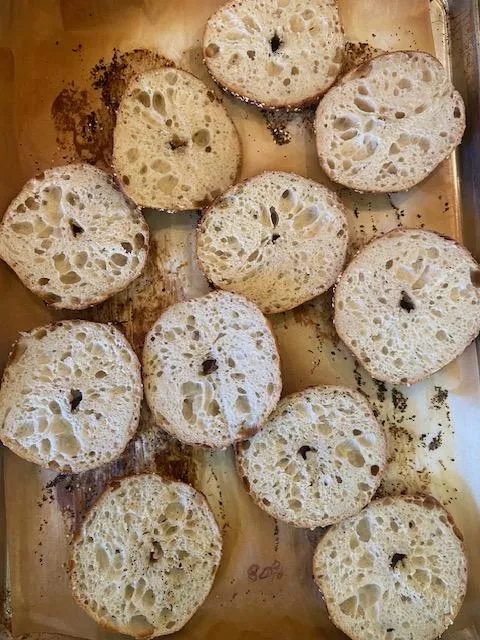
Image
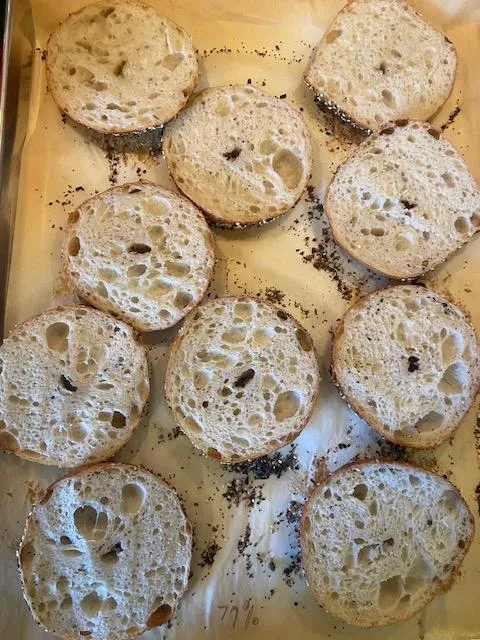
I’ve been following this thread silently and i am obsessed! i have never and probably will never try the real deal as i live in norway but i really want to give it a go! i’ve got my dough in the fridge right now but got a little overwhelmed with all the information so its kind of a mix of all the ideas and recipes. i’m very new to sourdough so this might be a disaster 😬
did you give it another shot? i’m so invested! thank u for your service 🫡
I have made four additional batches.I confirmed that 82% hydration using 100% high-gluten flour was a good formula for delivering an open crumb, but 84% was less open. I then tried integrating T110 wheat flour into the blend with a slightly lower but still acceptable
Image
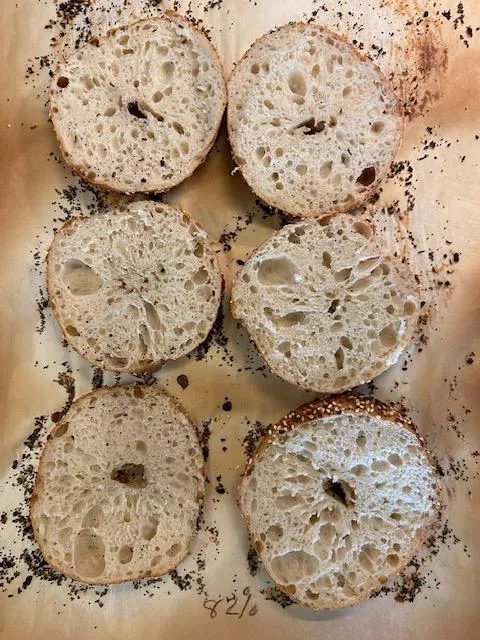
Image
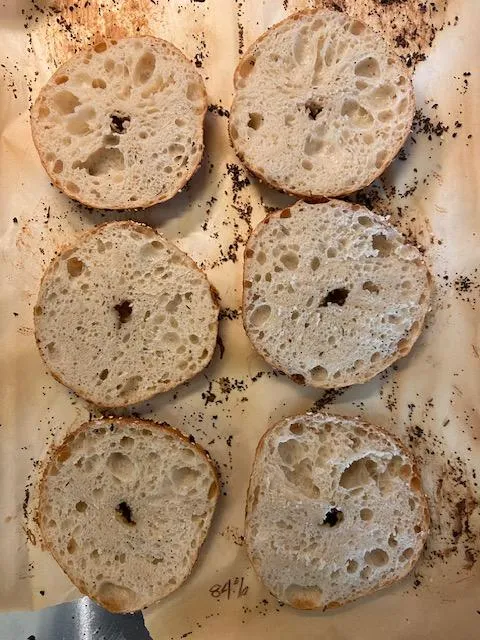
Image
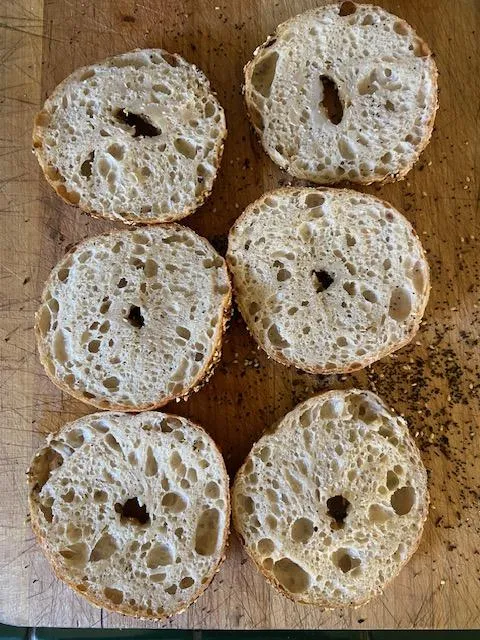
open crumb at 10% T110 and 20%T110, both at 82% hydration. The top photo shows 100% high gluten flour at 82% hydration. This middle photo shows 100% high gluten flower at 84% hydration. The bottom photo shows 82% hydration with 10% T110 flour in the blend. Good luck with your efforts!
ugh, stunning!!! i think working with dough at or above 80% hydration is a little scary for me right now.
i just took mine out of the oven and as expected its a bit of a disaster. they are quite gummy and wouldn‘t float in the water so either under or overproofed? i leaning towards the latter because i let them proof at 75 f for about 3 hours after mixing and then for another 90 minutes after shaping when i took them out of the fridge. dough didn’t rise alot though :/
i used a mix of bread flour (12%) and 00 flour (14%) because we dont have any bread flour higher in protein here
the person that created apollo bagels had a pizza shop called leo sourdough first and i thought the crumb of the bagels resembled the crumb of a neapolitan pizza so i thought i’d give it a shot!
heres a pic of my sad gummy bagel! i also cut into them when they were still quite hot so that might have attributed to that
Image
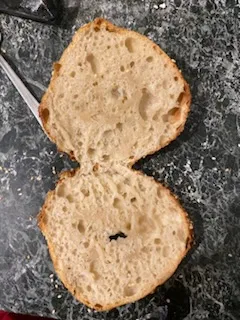
That doesn’t look so disastrous, and it probably tasted pretty good. My hunch is that you overproofed, assuming your levain was fully active. I put dough in fridge after two hours, rather than three, after having given the dough four folds. The bagels should float right away.
ok lovely, thank you!
so do you put your dough in the fridge immediately after the last fold? i also added honey to the dough, i’m not sure if you did too but that might have sped up the proofing too. i’ll also try lowering the hydration a little bit. they flattened quite alot after shaping and proofing and weren’t very managable. i’ll be back!
thanks for sharing your knowledge!
Happy to help. A couple other potential issues are folding and shaping the dough sufficiently to build strength, I’m not sure how your flour blend behaves but the high-gluten flour I’m using has a lot of extensibility that allows quite a stretch when folding and later when shaping into a fairly tight ball.
And yes, I do put the dough into the fridge immediately after the last fold because there will be additional rising in the fridge. Honey would accelerate fermentation, I don’t put it into my dough.
A lot of mentions of rice flour on this thread. Do we know for sure that Courage use it?
rice flour or other starchy flours as a dusting flour or inclusion in the boil water are just suppositions as to how they achieve the shattering crust.
i wish one of y’all that live in LA would get a job there, or start dating a past or present employee and get some good espionage.
Also curious about this, but I think the shattery crust is due to really good gluten development and high hydration. That being said has anyone ever tried crisp film or evercrisp to dust bread?
This is a hybrid bagel with an overnight poolish and 5hr levain. I used t85 and galahad mixed in with honey, barley malt syrup. 4hr table bulk. I pre-shaped into balls and chilled overnight before poking them.
Dearest comrades,
I am deeply thankful to all of you for doing what most would have considered the impossible--recreating the legendary courage/apollo bagel. Because of your work ethic, commitment to excellence, and inspirational creativity, you SET a foundation for the past THREE years that will continue for future generations.
Allow me to introduce myself. I am but a humble home baker in Texas, and having tried Courage bagels 3-4 times, I knew I needed to recreate them back home. I have been reading this thread extensively for a little over a year and a half now, and finally finally finally, I have gathered the little courage and dignity I have to attempt these marvelous breads.
I had rather low expectations for my first batch, and I will say that I ran into several issues (mostly my inability to plan ahead and THINK!) that probably decreased the quality of my bagels, but nevertheless, I am delighted to share that my bagels are 1) VERY VERY CRISPY on the outside, 2) filled with large alveoli, and 3) deeply dark brown on some spots (will share more later).
Here's the receipt I used (feel free to share your thoughts and what could be improved!)
Dough Recipe (75% hydration):
1000g bread flour (texas costco)
725g tap water
22g salt
I mixed (30min), added salt (30min), 4 folds (2rs), bulk proofed for 4 hours, divided and shaped (each bagel had a wild range of 150-190g), dusted them generously with bread flour, put a baking sheet to cover them, and then cold proofed overnight (5 hours).
I woke up at the (butt)crack of dawn, created the boiling water found in the thread (2200g water, 25g light brown sugar, 10g diastic malt powder, NO lye though), and boiled each bagel for 60 seconds, more or less. I immediately added sesame seeds to all but one of them (the ugly one was eaten plain)
Here is a big fail. I preheated the oven too late, so after boiling, I ended up waiting for the oven to preheat to 550F for around an additional 20 minutes, thus cooling my bagels back to room temp. I'm not sure what this did to them, but i'm sure it did something.
To make matters worse, I attempted to bake a sourdough loaf while also baking the bagels, so I had one rack at the bottom (4 bagels) and another rack on the top. I also had my pizza steel AND LODGE combo cooker inside while preheating, so I think despite the fact that one set of bagels wasn't getting cooked as quickly, the heat retention from the steel and cast iron vessel was beneficial to my bake time.
I baked 10 minutes, then flipped 10 minutes, then 5 minutes, and I should've flipped one more time, but I was getting pretty tired, so I just took em out and lo' and behold, they actually looked rather decent! No, they didn't have that dark brown color of courage bagels, but I COULD TELL they were finna be hella crispy.
After 10 minutes of cooling and unable to wait any longer, I grabbed one and sliced it open to examine the crumb. It was surely open, much like the door of love is open to anyone who doth seek it in true earnest posture. At this point, I was in hypothermic shock from excitement and anxiety, but I raised the bagel to my mouth and took a bite...
"CRUNCH!!! CWISP! CCCCCRRRISSSSSPYYY!!! YPIEE!!!"
Flavor slapped my face over and over again. Texture grabbed me by the shoulders and told me that liberation is found in the waves of sound. Blessings broke into the nooks and crannies of my being and suddenly, I found myself writing this testimony to this congregation that we call the fresh loaf.
ok cya,
@potatopeelpieboy on instagram
What percentage of levain did you do? Also, thank for for your kind words and keeping this going
finally some progress
I used super strong flour long ferment built with a poolish (fresh yeast) - bulked overnight then shaped into balls and poked before boiling and baking in super super hot oven.
I would love to have a go with a natural starter and some fresh yeast for the spring but starting to get that skin - crust - that courage seem to get - i still think you / i have to push the hydration hard and really time the bake so they don't' over prove - let me know your thoughts and any updates from around the world.
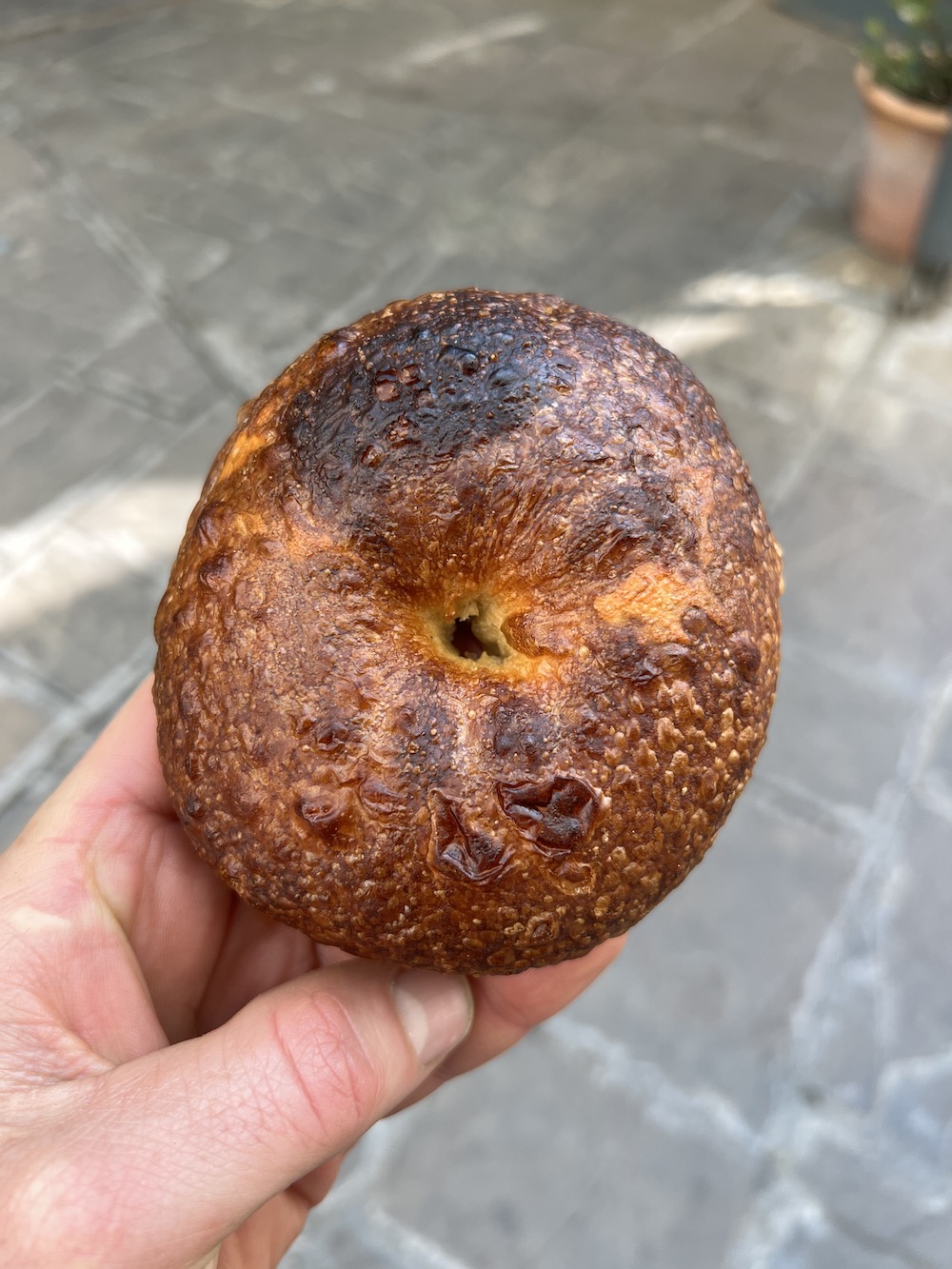
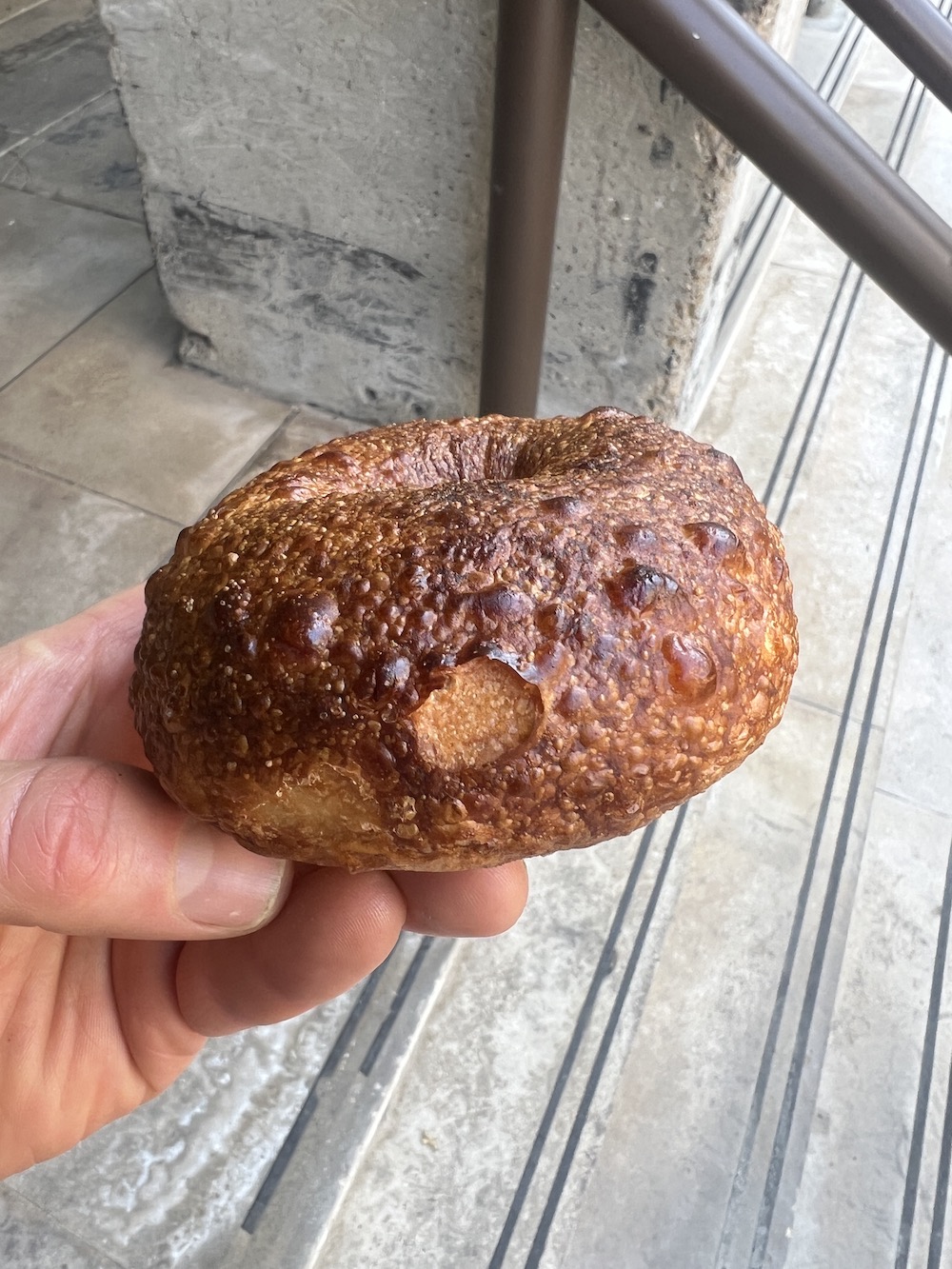
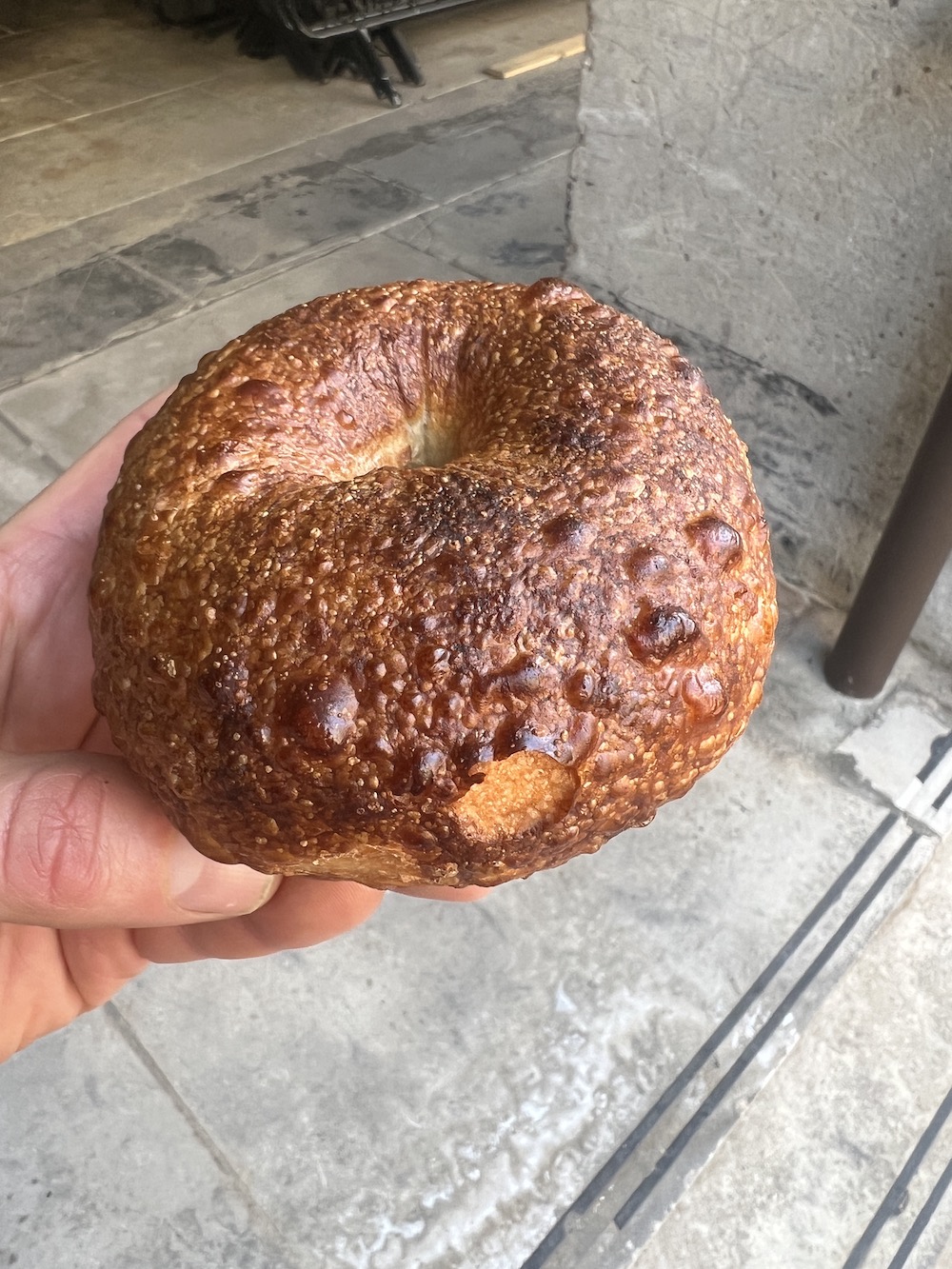
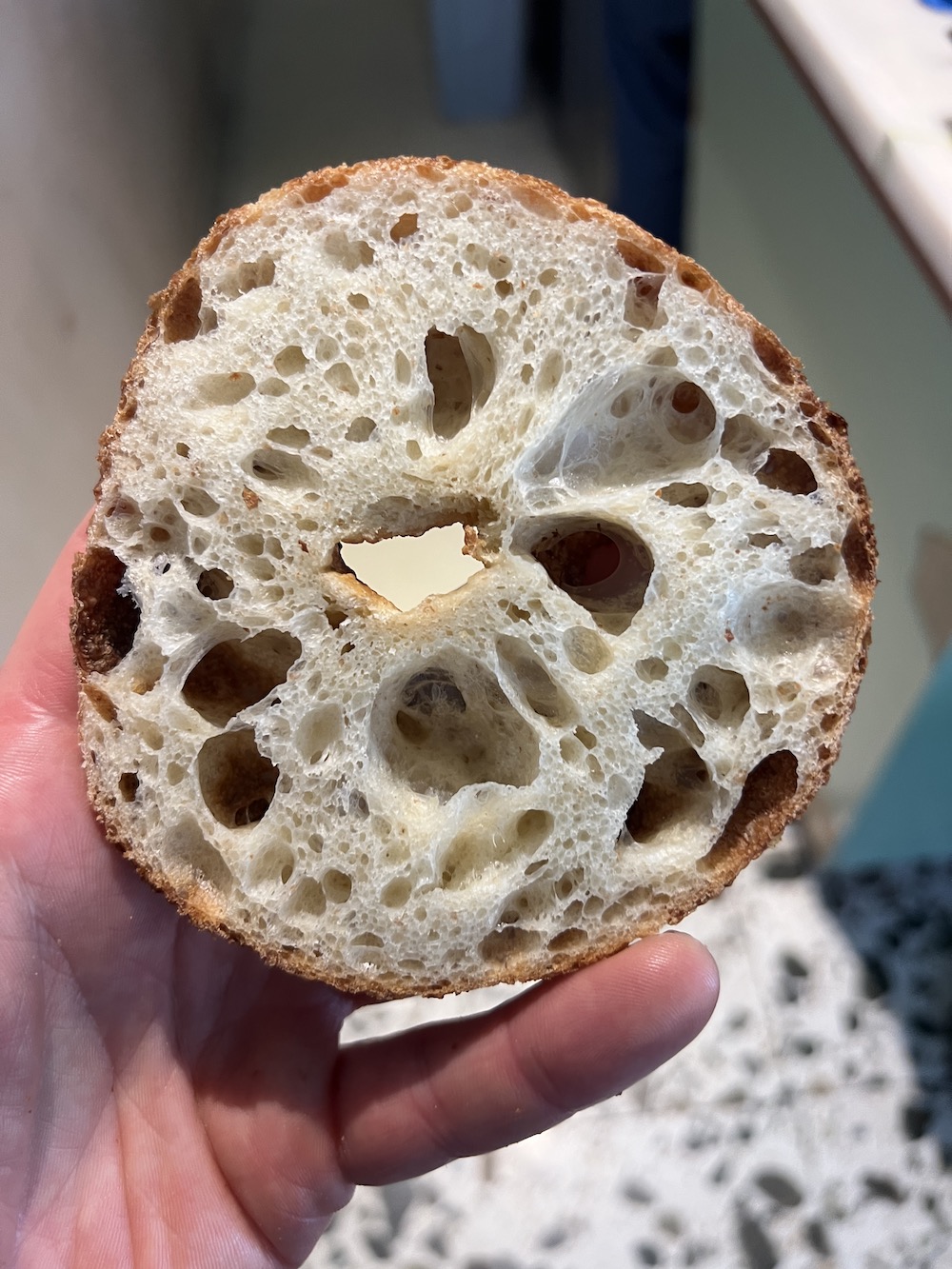
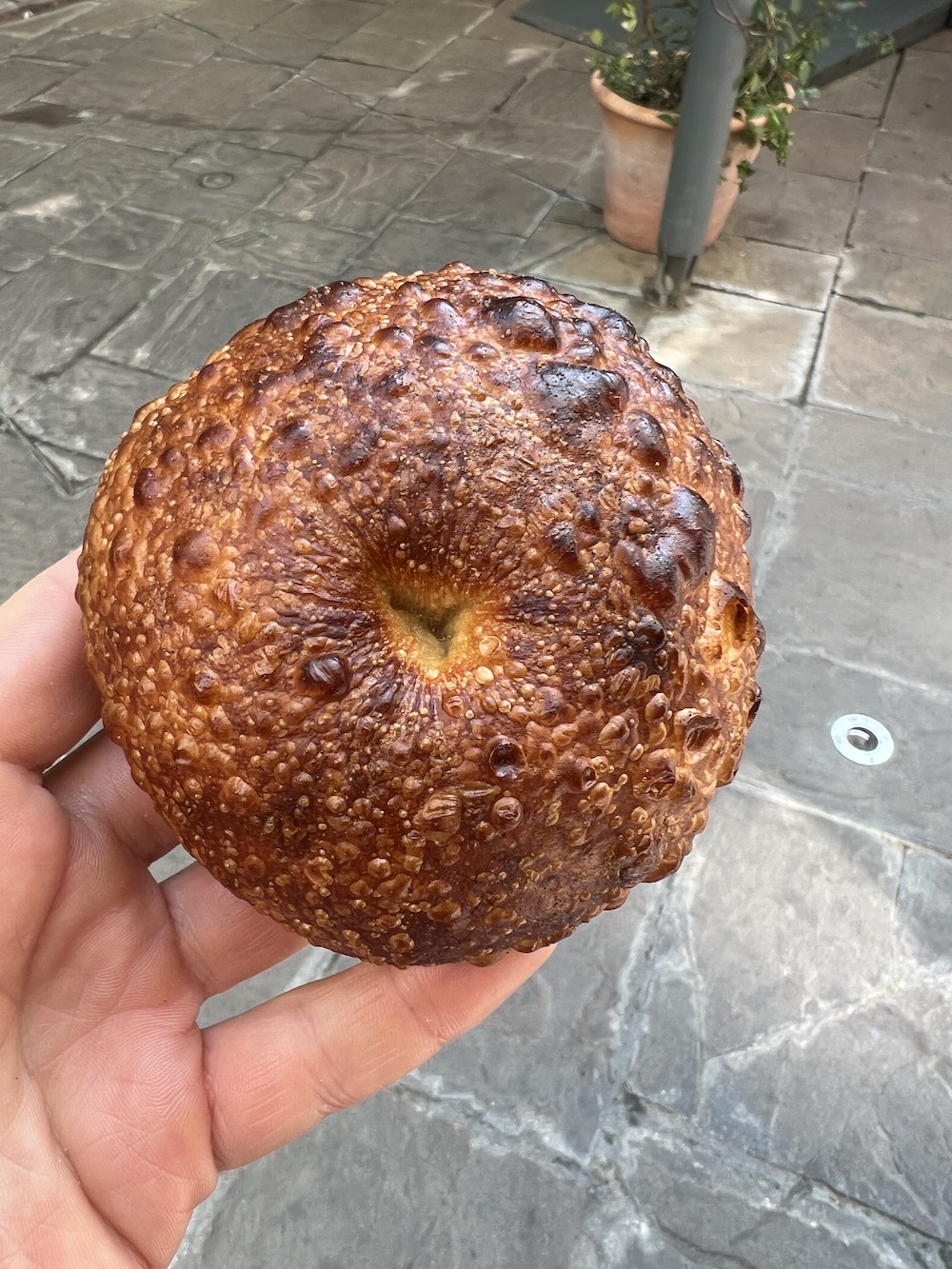
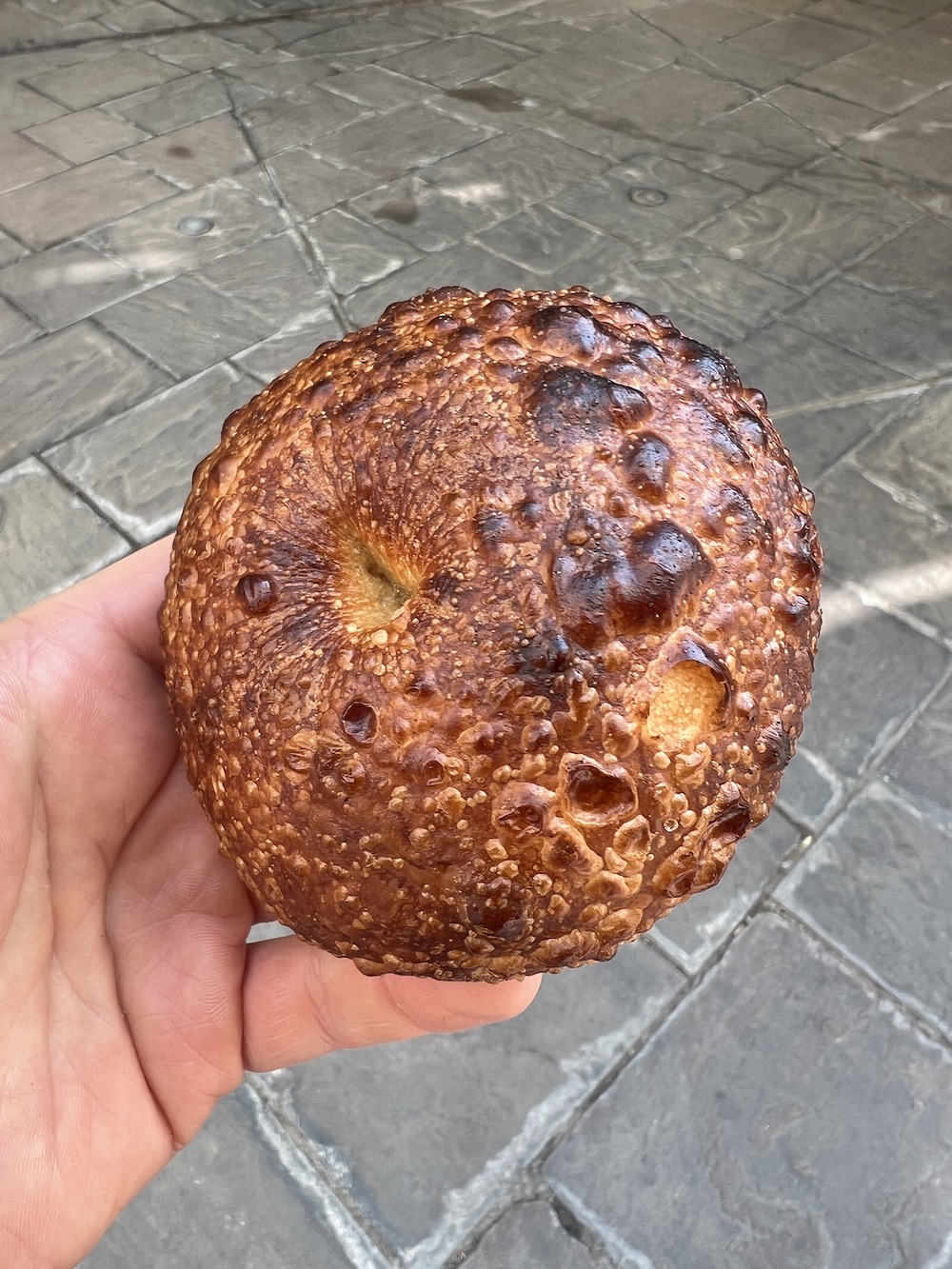
sorry 🙆♀️ peace and bread be with you
...but, someone who has been a member for two minutes and is new to bread should do a lot more reading--particularly this entire thread--before asking such a question. No disrespect, but we have problems with scammers and trollers. You can learn plenty by studying this thread and doing searches on TFL.
Beautiful job, Bob.
Bob that is a mighty fine blistered crust. Well done!
To what do you attribute the blisters (especially having read this thread I can see you've been at it some time!)
-Jon
Had to give the courage bagels a go, even if I don't live in the same continent.
Following the discussion here, tried out a 70% hydration sourdough dough with 0.5% diastatic malt and 20% inoculation with levain. Increased protein to 14% by adding extra vital wheat gluten. Baked in a hot oven (250°C) on baking steel. Dusted with rice flour and corn flour.
The good: an easy way to shape and boil. May change the way I normally make bagels. Who would have thought open crumb bagels were possible! Very light feel in the hand compared to my usual bagels.
The bad: While I had a little bit of crispiness to the crust it wasn't perfect, still need to get that crackle that is written about.
I think it needs a long time in the fridge (days!), as I suspect that is what will give the crispy crust. Mine had a 3 hour warm bulk before fridge, then next morning out for 3 hours after shaping then back into fridge for a couple of hours to chill before boiling and baking.
Boiled in water with barley malt extract as I normally do, perhaps there is also a trick to what goes in the boiling water (dextrin maybe?) to help the crust.
Will try again, love a challenge +bagels 😀
-Jon
To achieve blisters you have to have your dough and gluten really well formed and worked in the mixer - so gluten and strength is there.
You also just need to make sure its not over or under proved and you have the correct amount of starter ratio - i use a poolish at 20% - i think you need a hint of yeast as well to help with the spring - i don't believe courage bagels only use a natural starter im sure they also hit there mix with yeast. my dough is an overnight process with an over night poolish - and im sure its similar to courage who have a tiny shop and from a commerical POV you couldnt hold tons of dough for 3 days its wouldnt be viable i dont think from a business POV.
My tips are
you need to mix the dough in a mixer to really work the gluten
then give it a few folds before fridging overnight
i boil them in Dark brown sugar - i think this helps the crust aswell and colour
And im lucky as i have access to a commercial rational convection oven where i start the bake at 230 deg c with high humidty - a hot hot oven will really help i think this is really hard to achieve at home on a regular oven (from photos of courage they have convection ovens and i imagine when those things are full and pumping of bagels it creates its own steam and moisture which would create the crazy glass crust they seem to acheive) (i ve been baking a full oven worth so 40 bagels at time - in a small commercial setting)
Im in the uk and all i use is a canadian strong wheat flour to achieve these crusts (seems to be the strongest protein flour in the uk)
I also dust in rice flour
happy baking to one and all
my take on courage is
super hot ovens - piled with bagels also creates steam and heat
really well worked dough
natural starter and fresh yeast
some sort of sweetner in the water and perhaps there dough
strong strong white bread flour
they dust with semolina and rice flour?
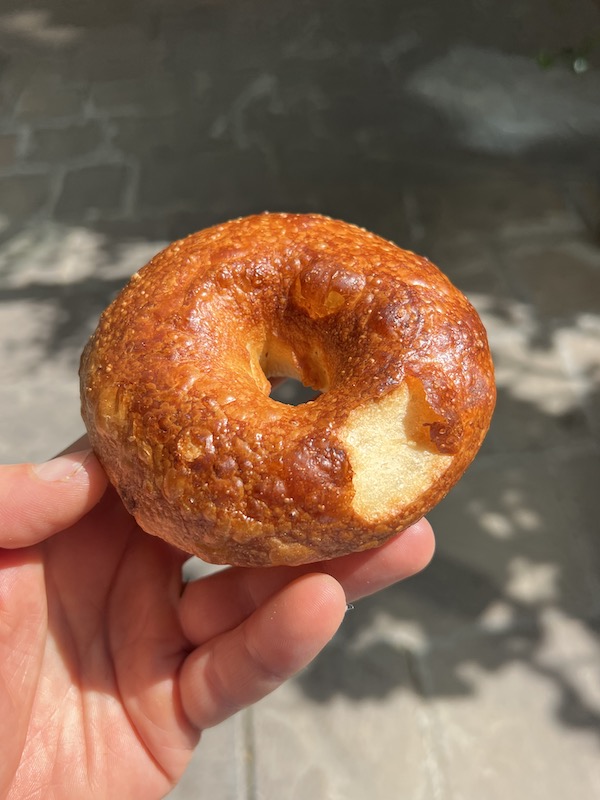
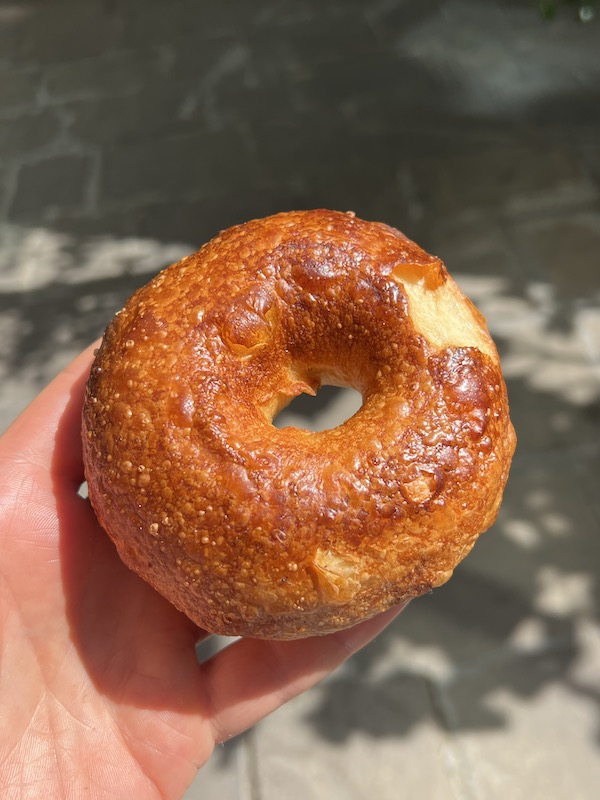
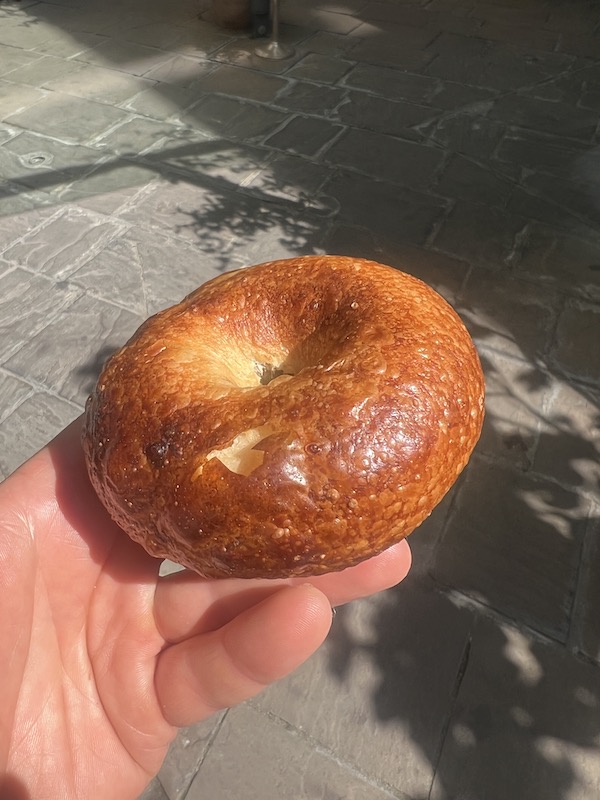
and good fermentation process
salt
thats its!
heres a bake from today best bake of the week you win some you loose some !
Lovely flaky crust, thanks for the feedback.
Do you add extra steam with the rational oven? I've never steamed my oven for bagels since the bagels are still wet from boiling.
-Jon
Beauty.
Hi guys! Have been reading your comments for the past two years & checking in to see if there is any new info on this! Wondering if anyone has make a new discovery! I go to courage quite often & NEED to make it at home because their bagels are pricey!
let me know (: